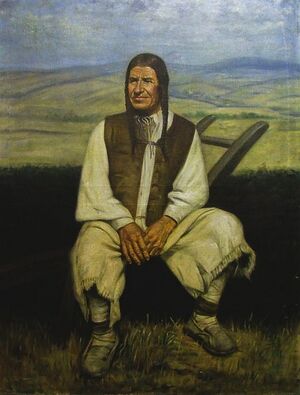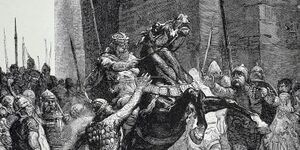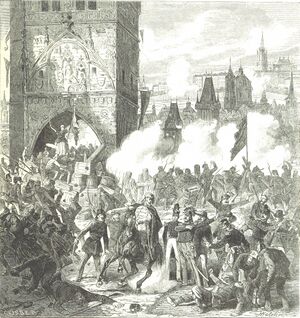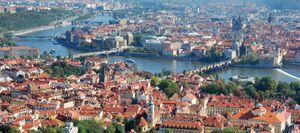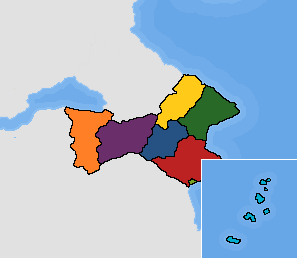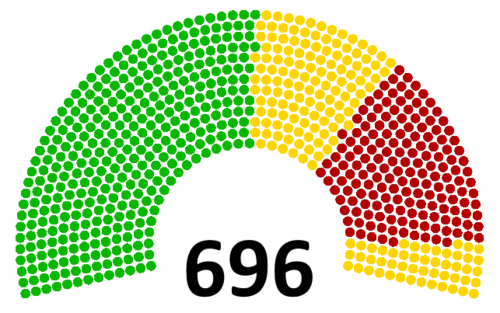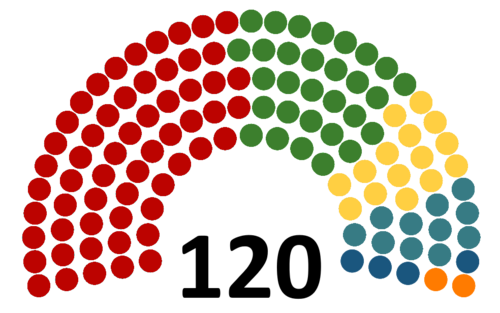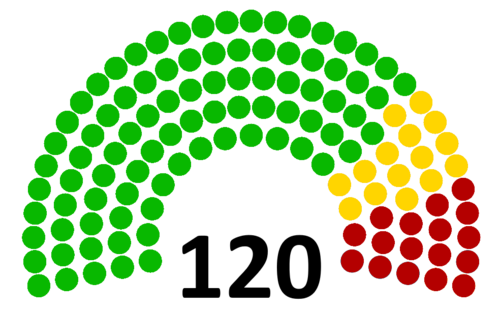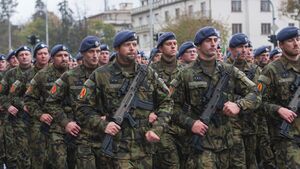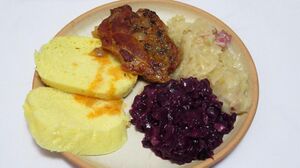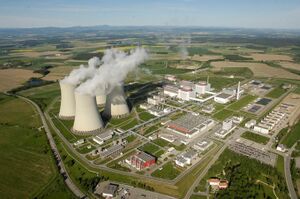Morrawia
Republic of Morrawia Morawská republika | |
|---|---|
Motto: PRAWDA WŽDY WÍTḘZÍ Truth always prevails | |
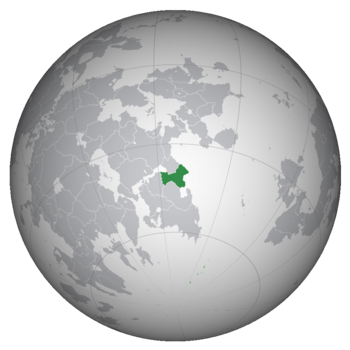 The Territory of Morrawia | |
| Capital and largest city | Králowec |
| Official languages | Morrawian, German, Polish, Tawuiinese |
| Recognised national languages | Morrawian |
| Ethnic groups (2018) | Morrawians (81%) Natives (5%) Hylians (3%) Others (11%) |
| Demonym(s) | Morrawian |
| Government | Federal Republic |
• President of Morrawia | Thomas Slawinský |
• Vice President | Marcel Pelikán |
| Legislature | The Federal Congress |
| The Senate of the Republic | |
| The House of Representatives | |
| Foundation Independence from Great Bohemian Empire (907 AD) | |
• Morrawian Civil War | 1000-1095 |
• Establishment of The First Morrawian Republic | 1574 |
• Imperial Age | 1645-1856 |
• Great Morrawian Revolution | 1852/1853-1856 (4 year and 7 month) |
• The Morrawian Constitution | 15th April 1861 |
• Bill of Rights | 21th August 1862 |
• Establishment of The Second Morrawian Republic | 19th February 1852 |
| Area | |
• Total | 480,500.63 km2 (185,522.33 sq mi) |
| Population | |
• 2021 estimate | 87 467 105 |
• September 2015 census | 81 234 149 |
• Density | 181.1/km2 (469.0/sq mi) |
| GDP (nominal) | 2020 estimate |
• Total | ACU 2,724 TRILLION |
• Per capita | ACU 31 310 |
| Gini (2017) | low |
| HDI (2018) | very high |
| Currency | tollar (₮) 1:1 conversion with real Dollar |
| Time zone | UTC0 (UTC) |
| Date format | dd-mm-yyyy |
| Driving side | right |
| Calling code | +415 |
| Internet TLD | .mo |
Overview
Republic of Morrawia, commonly called Morrawia, natively called Morawa and historically called Lands of the Morrawian Crown is a Federal Constitutional Presidential Republic in southern Anteria located entirely on the continent of Thrismari. It is bordered in the south by Wassilia. Morrawia has an estimated population of 87 million people. Morrawia comprises of 8 provinces (Wallawia/Waláwie, Bohemia/Čechy, Elbennia/Polabí, Iugopolinia/Jugopolina, Slowannia/Slowansko, Lechowia/Lechy, Tawuii and Federal District of Králowec). It has a very varied past ranging from times of absolutist monarchy, constitutional monarchy, imperialism and a republic. Morrawia today promotes democratic values across the world and is a significant power in southern Thrismari. Morrawia is also a member of Vedoti Pact and is a founding signatory Ardgan Treaty.
Etymology
The country's native name Morrawa is possibly derived from the Ainegols (Celtic tribe), who inhabited this area regularly starting in a 1st century BC, who named the river Morova (today Morawa), meaning stream or river, and then named a land after it. The other iteration could be from the other Celtic tribe named Bogois, who called the land Marav, apparently meaning field or grassland. The Common name Morrawia was formed in the 1600s from the already mentioned name Morrawa and the suffix -ia, denoting a people or nation. Country is comprised of 8 provinces, all with their own names based on rivers, landscape or people, who have been living in the area. These provinces are all made out of many smaller historical provinces, which exist to this day. For example Elbennia (named after the river Elbe) is comprised of historical provinces of Osterachia (named after people living there: Österchs), Panonia (named after Latin name for water) and Pylatonia (named after the ancient city Pylatald). Province of Walawia is named after the word wlát meaning wave reffering to wavy terrain of the original Morrawian territory with hills and valleys. Province of Bohemia is named after a Boii Celtic Tribe, which inhabited the area before any first state formed there. Elbennia derives its name from Elbe River. Iugopolinia is little complicated. Historically, north-eastern region, which is now called Iugopolinia was called just Polinia. After some time, there were certain inhabitants, which later divided themselves into Northern Polinia (Sewopolinia) and Southern Polinia (Iugopolinia) due to different lifestyles and other mainly political reasons. Rights before the rise of Great Bohemian Empire, which was created by invasion of that territory, Iugopolinian ruler Prabyslaw united the armies and invaded his northern neigbour. Thus creating big Iugopolinian state, now fully under his rule instead of being just a confederation of tribes. Shortly after that, said GBE (back than just Duchy of Bohemia) invaded the region and made it a core state in a greater nation, keeping the title of Iugopolinia. Slowannia´s name literally means Land of Slavs. Lechowia thanks for its name the tribe of Lechs, which was one of the first to join expanding Great Bohemian Empire. Tawuii derives from a local language meaning king´s islands with the name of the archipelago Oomoshi meaning land on the ocean
History
Birth of a nation
Morrawia was founded by Přemysel I., founder of the House of Přemysel, which is one of the longest-ruling dynasties in Morrawia´s history. He famously came to the Morrawian region with about 1000 other people, who lived nomadic life up to that point and famously said: "Go people, go and surprise not only the world but yourself too. Create a nation with no limits only of that of a SKY´S." The people at that time were mostly farmers and lived in small villages, one of them was soon to be Capital: Králowec, which grew at a rapid rate from its founding in 912. The land then was mostly forests, some marshlands, and mountains on the north and the west. This was the time of rapid expansion of Morrawia and all in all, it was a really unstable period for a young nation. The growth and relative prosperity itself continued for 70 years when during the reign of Yaromír I., the nation was starting to crumble, mostly thanks to the inability of Yaromír to rule himself. The territories of the nation were sold to the adversaries, people started to riot, and not even the next king, Moymír II. wasn´t able to rescue a dying nation and on the 7th of March, the nation dissolved and an Age of Chaos began, continuing well until the year 1095, where major fighting stopped, but the region was divided amongst many little kingdoms, duchies and earldoms.
Period the Age of Chaos
Eventually, the nation was put back together by Wenceslaus I. of House of Carthia as a Grand Duchy of Morrawia. Even though the rule of Carithians of Morrawia wasn´t the longest (only 3 Dukes), the greatly stabilized the nation, improved the lives of citizens, even expanded territory. But as was Boleslaw II. (last Carithian Duke) dying, he whispered the prophesy, that the House of Přemysel must return to throne and reign over the land, otherwise, there will be no Morrawia. His subjects listened, searching for a descendant of Přemysels and they found him, living as a lumberman in the woods of Šúmawa region. They asked him to be their king, he accepted and he restarted the reign of the House of Přemysel in Morrawia for approximately the next 500 years. He himself was named Přemysel the Great and starting with him, Morrawia was now definitely a Kingdom, title, it never lost to this day, with one notable exception in a far future.
Middle Ages
Things were looking great, the formation of large cities began at this time, although, majority of the population were still living in villages. But changes were made elsewhere too like economy or agriculture. Nation shrank and again expanded numerous times over this period. That during the reign of Bořiwoj III. and Wladislaw I. In this time period, two of the biggest Knight Orders were founded: King´s Order of the Golden Lion and Order of Tatras. These to orders were initially enemies, but throughout the years forged an alliance in the name of the monarch of Morrawia. They were also allied to Knights of the Isle of Soe and the City of Banter from Kakland. The next king, Přemysel VI. allowed women to become rulers. This was revolutionary. There was Ludmile I., favorite among the people, and lastly Anež I., who was sadly, the last monarch wearing the symbols, and ruling the Morrawia as Přemysel. She, even more, expanded the Kingdom, prolonging the border along the Kaldaz Ocean, but was sadly assassinated by Duke of Berburg, one of the rulers of the northern subdivision of Morrawia at the time making the House of Přemysel extinct and declaring himself as a ruler. He was nicknamed Albert The Killer for his cruelty. This was a dark period for Morrawia, as people were dying in the hands of Albert, it lost a significant amount of territory and his son Ferdinand handed power to Nobility and subsequently killing himself in Grand Palace of Králowec. This was the start of a short, weird but still interesting era: The Age of Nobility.
Age of Nobility
Age of Nobility was a 27-year long period, where The Monarchy was reorganized into a sort of elected aristocracy still caled Kingdom of Morrawia (without a king). This was the first attempt to create a truly representative democracy of voting in the nation. Morrawia was reorganized in terms of counties inside a nation. There were many counties, which were part of the historic provinces, now called States. If someone won a majority in the county, the whole county was theirs, if someone won the majority of counties in that given state, the whole state is theirs. This system is called the electoral college and is not used today in Morrawia. But things weren´t that optimistic. People COULD elect representatives, but the representatives were from the nobility and regular people weren´t allowed to run in elections. Also, women couldn´t vote, only men, and also, there was a VOTING FEE involved with voting nad not everybody could afford it. At the end of the day, it was an imperfect system attacked constantly by Monarchist Knights, Raiders, and other groups of people who didn´t like the new system. In 1601, the kingdom became so unstable and so disfunctional that it literally collapsed over night. noblemen, who were supposed to keep the country together, military and other forces slowly stopped doing their job. People were unsatisfied with the government and began rioting and looting. As everyone saw the inevitable, few groups took the matter into their own hands but only one walked out victorious. Noble family from the independent Kingdom of Elbennia called Awstrowitz in the matter of 2 months made friends on high places, some of which were their friends for a long time and promised stability to the people all over Morrawia and it worked. Awstrowitz negotiated with the government and other noble houses and became the ruling dynasty of Morrawia, as it was before the republic. Few other nobles ruled their own areas, but it wouldn´t take long and Awstrowitz consolidated all the power and Morrawia became absolute monarchy with Rudolf I. as the ruler.
Monarchy and transformation to the Empire
Things were back where they were before the the nobility rule. There was one ruling house with absolute power and lower nobles, who administred the lands given to them by the monarch. Rudolf I. was truly the king who delivered on his promises. He stabilized the nation, got rid of dangerous elements (and some of the opposition) and established firm rule of one house. All relics of republic were destroyed and new age began. After his long rule, which ended in 1640, 3 kings took the thrown between the years 1640 and 1645. In the second year, Augustus I. finished the process of international involment of Morrawia started way back during Morrawian Republic. He renamed Kingdom of Morrawia to Empire of Morrawia, created Imperial Senate, who directly answered to him and established agressive foreign policy of exploration, exploitation and for the first time in nations history, slavery. This massively boosted Morrawia´s economy and living standards and people were actually starting to live better. Slave trade continued until the end of a regime. This agressive policy consisted of rapid expansion of new territory on other continents, such as islands and such and taking resources of that area, while taking advantage of the people. A slave colony was established on the archipelago in southern Sunadic Ocean called Nowé Zámoří (today Tawuii), where all slaves, who were not yet divided into working groups. Following decaded saw rapid growth of economy, population and living standards (only for Morrawians). As governing the nation became more and more difficult, the government got bigger. In 1700s there was wave after wave of legislation to limit rights of all but white male Morrawians. But it slowly trnasformed itself into discrimination of everyone in the beginning of 1800s as slave trade was beginning to be less profitable. Second half of 18th century was all about stagnation and the 19th century was about decline. There were pirates, who were destroying fleets, bandits freeing slaves in Morrawia itself. It was a slow process but surely, Awstrowitz were starting to lose hold over Morrawia. Stagnation, decline, inflation along with no real technological and military progress made once great and feared empire weak and backward. This all escalated into what we call now Freedom War. Otto VI., who ironically was trying to reform the country, although with great resistance from nobles and his own family was met with even bigger challenge, than any of his predecesors: Morrawian Legions. Squads of armed militia man answering to one man Tristan Palacký, nobleman from Slowannia. This man was from the House of Tatrany, which was the most well respected House in all of western Morrawia. He was fed up with how the situation got bad. As he wrote in one of his 29 books, he dreamed of free future for everyone and for the government by the people. He gathered lot of people on his side all across the country to form organized militias. These militias, consisting mainly of farmers, but for example also some of the soldiers from Imperial Army declared Republic of Morrawia on 28th of October 1852, which is to this day celebrated as Republic Day, from a captured Grand Palace of Králowec balcony infront of thousands of people. These people and all around the country were encouraged to fight against the emperor and his family and everyone, who stands by them. This started the Great Morrawian Revolution, with lasted until 1856 and ended by the complete colapse of imperial regime, arrest of Awstrowitz family and execution of Emperor Otto VI. After the war, new Morrawia rose, one which was bound by law, not royalty as said by its first president Tristan Palacký.
Republic and modern times
There was a complete shift after the war. The new democratic system was put in place. Tristan Palacký was offered the presidential seat, and he excepted. He was given a blank canvas on what powers should president hold. He then set an example for all future presidents by serving two fixed terms of 6 years. The term was shortened to 5 years in 1895. So called Republican Assembly was formed in 1856, which was renamed Federal Congress a month later, which was the legislative body of the nation. Electoral college was established in the beginning and than abolished in 1901 and was exchanged with proportional voting system. Federal Congress from the start had two chambers: Senate of the Republic and House of Representatives. Senate was there to ensure that democracy stayed in the nation even if the House fell or was dominated by one party. Throughout the 19th century, more and more people were given right to vote. In 1903, voting for women was passed and this was a gamechanger. In 20th century, Morrawia experienced its second golden age after The Great War, where it was fighting on the side of democratic states (by supplying them with weapons, military equipment and food) against the imperial ones. Thanks to fight never being on its territory and stability after the war, Morrawian economy exploded. During the Era of Civil Wars, Morrawia has seen itself elevated to the status of big power. In 1948, it was one of the original signatories of Argdan Treaty, which guaranteed basic human rights. Country has seen one unsuccessfull coup attempt in 1964, which was quickly put down right in the beginning, but saw the death of President Wallmark in the hands of one of the people responsible for a coup. For the rest of the century, country grew in population and economy and today is considered progressive socially and economically. Although these trends of social and economic progress continue, country still experiences frequent shifts in the political sphere, where the right-wing government rules for couple of years and then is replaced by the left-wing government for some years. It is only certain policies, which no party can mess with, because they are very popular with the people.
Geography
The Morrawia lies mostly between latitudes 48° and 51° N and longitudes 12° and 19° E.
In Morrawia, there are main two river basins: Elbe River Basin and Morawa River Basin. Both rivers originate in Izzer Mountains in the north of the country. It's one of two mountain ranges in otherwise slightly hilly and also, moving closer to the coast, very plain country. The other mountain range is in the west and is called Great Tatras Mountains. The highest point in the country is Mount Snow Peak (Bílá Snęha) - 2501 m.
Elbe River flows to the west to the Torgea Strait. Morawa River on the other hand flows to the southeast, straight through Králowec and into the Bay of Morawa. There are also amongst others, 4 smaller major river: Wágh River, Nutra River, Sézawa River and Woltawa River.
There are 7 national parks mostly in the west. These are: Izzer Mountains National Park, Modrá Woda Canyon, Šúmawa National Park, Great Tatras National Park, Beskidian Plateau, Sunadic Marshlands Terittory and Přemysel National Park + 17 other smaller nature reserves. There are also some nature reserves in Tawuii.
Climate
Morrawia has temperate climate, with oceanic climate in the east and more contintal in the west. This causes the Western and Central part of the nation to have bigger difference between temperatures during summer and temperatures during winter. So whereas East gets milder (but still hot) summers and mild winters, Central and Western part of Morrawia gets very hot summers and snowy, windy and cold winters.
The coldest month is usually January, followed by February and December. During these months, there is snow in the mountains and sometimes in the cities and lowlands. During March, April, and May, the temperature usually increases, especially during April, when the temperature and weather tends to vary during the day. Spring is also characterized by higher water levels in the rivers, due to melting snow with occasional flooding.
The warmest month of the year is July, followed by August and June. On average, summer temperatures are about 20–30 °C higher than during winter. Summer is also characterized by rain and storms. Autumn generally begins in September, which is still warm and dry. During October, temperatures usually fall below 15 °C or 10 °C and deciduous trees begin to shed their leaves. By the end of November, temperatures usually range around the freezing point.
Throughout the year, the coldest temperatures are recorded in Tawuii.
Demographics
Morrawia is relatively homogenous society with over three quarters of citizens identifying as Morrawian. There is significant number of immigrants from Hylia. At the same time, many people from Morrawia emmigrated to Hylia in its history. So the demographic composition is as follows:
Ethnic composition of Morrawia (2018)
Language
Morrawia has many languages and many of them are even official. First one is Morrawian. Morrawian language is a Slavic language, written in Latin script. Spoken by over 90 million people, it serves as the main and official language of the Morrawia and all of its provinces. Other languages spoken in individual provinces are German, Polish + many of native languages of Natives (broad term for every native tribe or community).
Many of these languages are very similar to Morrawian, Bohemian being closest to it, though its considered a dialect. They are written little bit differently, spoken word can be understood by any other language speaker, with exception of Native languages and German, which is a Germanic language instead of Slavic one. Morrawian is a fusional language with a rich system of morphology and relatively flexible word order.
These languages are tought in schools accordingly with Morrawian as a first mandatory language and then languages spoken in provinces. These second, optional, languages can be added to school curriculum by local Congresses. More on that, other languages spoken in a kingdom can be ofcourse tought in schools, though only through school courses (except the Common language, which is mandatory). Bohemian, German and Iugopolish are these languages, spoken in Elbennia and Iugopolinia respectively. Provinces of Bohemia, Slowannia and Lechowia speak Morrawian with a slight dialect and don´t have their own language.
Here we will analyze Morrawian:
It has 36 letters. The full list of letters is: Aa Áá Bb Cc Čč Dd Ee Éé Ḙḙ Ff Gg Hh Ii Íí Jj Kk Ll Mm Nn Ňň Oo Óó Pp Qq Rr Řř Ss Šš Tt Uu Úú Ww Xx Yy Ýý Zz. The stress is always on the first syllable. Words can be relatively flexibly move around the sentence and still make sense. Foreign words are written exactly like they are in that particular language with possible acception of pronouns, though its not always the case. There are also sounds, the standard alphabet doesn´t have a letter for. The whole language dates back to the 7th century.
Religion
Religion in Morrawia (2015)
Religion has been historically a religious nation, though Morrawia is constitutionaly secular country. There are many religions in Morrawia, with one of them being Morrawism, an offshoot of Protestantism, officialy called Church of Morrawia. Other notable religions are Protestantism and Catholicism and given, that there are many native tribes still living in Morrawia, they have their own religions too, completely supported by the government with exception of bloody rituals and similar gruesome events. There is also growing Irreligious community since the 20th century and is 2011 census, almost 12% of the population is irreligious.
While absolute majority of the country is either Protestant or Morrawan, almost all of Elbennia is of Catholic faith. This is due to various factors, with one of the most important being, that Elbennia isn´t Slavic, it has Germanic culture, quite different from the rest. Catholicism appeared in the area of today's Elbennia in the 1st Century AD. Protestantism evolved in the rest of the country in the 1500s as Slavic population didn't really got along with catholics through the centuries. So they accepted Protestantism as they´re main religion, as it was more liberal. Today, it's mostly in Iugopolinia, Lechowia and in some parts of Slowannia with hotspots around the Bohemian coast.
Both Catholic and Protestant faith believe in one God. Protestantism being more free is also more prevelant in the country coming to Morrawia from abroad. Morrawism formed in the times of the rule as a mean of protest against establisment. Starting in Bohemia in the little town of Waršawice, created by the local protestant priest Adam of Waršawice, Morrawism quickly spread though Morrawia especially in Iugopolinia, Slowannia and Bohemia thanks to its friendly rules like no compulsory donations, no gold in churches, only other metals, no celibacy or fasting. Priests could have families and people could divorce. Women could become church dignitaries etc. Today, this religion is strong mainly in Morrawia, Bohemia, Slowannia and little bit in Lechowia with some hotspots in Elbennia and Iugopolinia and also in Tawuii. The head of The Church of Morrawia the Supreme Priest of the Church of Morrawia selected from priests all around the country with a lifetime term.
Ethnicity
Morrawia was and still is very multi-lingual and multi-ethnic nation. This phenomenon can be traced to the founding of the nation where Přemysel I., first King of Morrawia was called formally "HEAD OF ALL MORRAWIAN PEOPLE". By these, he meant even the little ethnic groups in the nation.
Health
Public Healthcare in Morrawia is one of the best in Anteria. Rating TOP 100 in the region, standard of healthcare is generally high. The affordability and standard of medical treatment has even seen the country emerge as a popular destination for medical tourism on Anteria.
It is compulsory to have health insurance in Morrawia, whether trhough a public or private health insurance provider. Citizens, residents and anyone working for a Morrawian employer are automatically insured under the country´s public healthcare system and pay monthly contributions. Many doctors are in public hospitals though many are in private ones and the healthcare there is just as excellent. Morrawia provides free medical care to all citizens, permanent residents and foreigners working for a local company through compulsory contributions to an approved Morrawian health insurance company. Employers, it is mandatory to pay a portion of the monthly fee with the employee contributing the remainder of the fee. Pharmacies are widely available all across Morrawia, with some opened 24/7. Some of them are even attached to hospitals. Emergency services in Morrawia are generally good, as are ambulance response times. In the case of an emergency, dial 199.
Education
Education in Morrawia includes 4 levels of education: Pre-School, Elementary, Secondary and Higher. For students ages two to five, there are preschools called Community Schools that are generally not state-funded until the years before elementary school. There is also a number of private schools is present across the country. Elementary school is mandatory for children from ages six to sixteen. After that, some students leave formal education altogether, while other students attend other types of school. Enrollment in public schools is fairly high, though these figures do not document active student engagement.
Morrawia's education system is governed by the Ministry of Education with 12.7% of the Morrawian Government Expenditure going into it. Elementary school consists of nine grades and is grouped into two stages:
After preschools, kids usually enroll into the nearest county elementary school. There, they learn in a same class 9 years. The last year, children either go to elementary school for another year or they can go study in another school, specifically Special Vocational Schools (SVS), which consists of 5 years of studying their subject of choosing. There are also two other options. If they finish the last year of elementary school, they can attend 4-year Academy, with a specific specialization to one subject. Option B is to go to 8-year Academy in the after 5th grade (instead of going to 6th grade), with four years of mandatory learning and then option to continue another four (optional) years or go to SVS. In the last year of either SVS or Academy, they must pass National Finals Test to pass the school. Every Province have their own NFTs, but National Curriculum exists, which give provincial school districts a framework for not only NFTs, but the whole education in general.
The next big step is either going straight to work, or going to University. Every Province has at least 3 Universities and there are 2 in Tawuii. The length of Universities varies from 6 to 10 years in total. The best universities are Palacký University in Králowec, Morrawian Royal College, University of Tatrany and Overseas University of Leopolná.
Largest Cities
Largest Cities in Morrawia
Morrawian 2018 Census | |||||||||
|---|---|---|---|---|---|---|---|---|---|
| Rank | Province | Pop. | |||||||
| 1 | Králowec | Federal District of Králowec | 4,539,961 | ||||||
| 2 | Berno | Province of Wallawia | 2,029,794 | ||||||
| 3 | Ášen | Province of Bohemia | 1,236,865 | ||||||
| 4 | Pilzáň | Province of Bohemia | 1,097,162 | ||||||
| 5 | Olomóc | Province of Wallawia | 793,766 | ||||||
| 6 | Elbennitz | Province of Elbennia | 525,973 | ||||||
| 7 | Waldstein | Province of Iugopolinia | 392,490 | ||||||
| 8 | Tatrany | Province of Slowannia | 354,917 | ||||||
| 9 | Zeliná | Province of Lechowia | 295,738 | ||||||
| 10 | Leopolná | Province of Tawuii | 201,648 | ||||||
Government
The Federal Government (The Government of Morrawia) exercises legislative, executive and judicial power in the Morrawia. The members of the government are the President of Morrawia, the Vice President and 14 other ministers. It has its legal basis in the Constitution of Morrawia. The government is led by the President, who selects all the remaining ministers at hand and it's elected for 4 years. The Presidents Cabinet is not responsible to the House of Representatives, although, President can get impeached under certain curcumstances.
The President is elected in two round election with proportion voting. The current President is Thomas Slawinský of the Liberal Party. The current government was sworn in on July 27th, 2020. It has 14 members + 3 non-ministrial members and a President. It consists of the following members:
President - Thomas Slawinský (Liberal Party)
Vice President - Marcel Pelikán (Liberal Party)
Minister of Foreign Affairs - Simone Jiráskowá (Liberal Party)
Minister of Energy - Dawid Rozstál (Liberal Party)
Minister of Treasury - Karolíne Thamowá (Liberal Party)
Minister of Defense - Radim Fiala (Liberal Party)
Minister of Justice/Attorney General - Friedrich August (Liberal Party)
Minister of Commerce - Ondřej Pavelec (Liberal Party)
Minister of The Interior - Iwan Bartoš (Liberal Party)
Minister of Health - Emil Nowák (Liberal Party)
Ministry of Labour & Industry - Vojtḙch Kratochwíl (Liberal Party)
Minister of Education - Tadek Kocián (Liberal Party)
Minister of Transportation - Sebastian Rëtzmayer (Liberal Party)
Minister of the Environment - Wladimír Kučera (Liberal Party)
Ministry of Heritage - Josef Hawel (Liberal Party)
Minister of Agriculture - Monika Sedláčkowá (Liberal Party)
Director of National Security - Walter Schölz (non-affiliated)
Trade Representative - Thomas Mažík (non-affiliated)
Chief Economic Advisor - Stela Rhátowá (non-affiliated)
Lower House (House of Representatives)
House of Representatives has 696 members from every Province. Elections are held every 4 years and seats are proportionally distributed per votes.
| House of Representatives Political Distribution: | |||||||||||
|---|---|---|---|---|---|---|---|---|---|---|---|
| |||||||||||
| Color | Name | Nick | Political Leaning | Number of Seats | Affiliation | ||||||
| #BC0300 | Liberal Party | Liberals | Progressive left | 353 / 696
|
Government | ||||||
| #FFCF42 | New Democratic Party | New Democrats | Moderate left | 127 / 696
|
Unaffiliated | ||||||
| #1A567E | Republican Party | Republicans | Conservative right | 114 / 696
|
Opposition | ||||||
| #377B84 | National Party | Nationals | Conservative right | 52 / 696
|
Opposition | ||||||
| #3C7F2D | The Federalist Party | Federalists | Liberal centre-right | 50 / 696
|
Unaffiliated | ||||||
| Current House of Representatives Speaker: Andrej Pysařík | |||||||||||
Upper House (Senate of the Republic)
The Senate has 120 seats, which are distributed proportionally per votes, but only third of the seats are replaced every 2 years and votes are offset by 2 years (meaning that it takes a minimum of 6 years to completely change a senate). Political party can get 59 seats max, ensuring the need for a coalition to control the Senate.
| Senate Political Distribution: | |||||||||||
|---|---|---|---|---|---|---|---|---|---|---|---|
| |||||||||||
| Color | Name | Nick | Political Leaning | Number of Seats | Affiliation | ||||||
| #BC0300 | Liberal Party | Liberals | Progressive left | 58 / 120
|
Coalition | ||||||
| #3C7F2D | The Federalist Party | Federalists | Liberal centre-right | 30 / 120
|
Coalition | ||||||
| #FFCF42 | New Democratic Party | New Democrats | Moderate left | 15 / 120
|
Unaffiliated | ||||||
| #377B84 | National Party | Nationals | Conservative right | 11 / 120
|
Opposition | ||||||
| #1A567E | Republican Party | Republicans | Conservative right | 4 / 120
|
Opposition | ||||||
| #FF7B00 | National Unity Alliance | Uniteries | Populist far-right | 2 / 120
|
Opposition | ||||||
| Current Senate Speaker: Jolana Woříškowá | |||||||||||
| Province | Population | Capital | Governor |
|---|---|---|---|
| WALLAWIA | 35 670 000 (31 130 039 without Králowec - official way of showing population) - 211 seats in House of Representatives | Králowec | Radek Potmęšil (Liberal Party) |
| BOHEMIA | 13 050 000 - 104 seats in House of Representatives | Pilzáň | Jana Stránská (Republican Party) |
| ELBENNIA | 10 875 000 - 87 seats in House of Representatives | Elbennitz | Johaness Engel (New Democratic Party) |
| IUGOPOLINIA | 9 135 000 - 73 seats in House of Representatives | Waldstein | Alexandr Zawadzký (Liberal Party) |
| SLOWANNIA | 7 830 000 - 63 seats in House of Representatives | Tatrany | Petr Řehák (Federalist Party) |
| LECHOWIA | 6 960 000 - 59 seats in House of Representatives | Osterawa | Zuzane Dostálowá (Republican Party) |
| TAWUII | 3 045 000 - 24 seats in House of Representatives | Leopolná | Adam Táborský (National Tawuii Party) |
| FEDERAL DISTRICT OF KRÁLOWEC | 4 539 961 (sometimes considered the part of Province of Wallawia) - 75 seats in House of Representatives | Králowec | Zdenęk Vídeňský (Liberal Party) |
Military and Foreign Relations
Morrawian Armed Forces consist of the Morrawian Army, Morrawian Air Force, Morrawian Navy, Morrawian Coast Guard, Morrawian Marines. The armed forces are managed by the Ministry of Defense. President of the Republic is a Commander-in-Chief of the armed forces. In 1658 the army transformed itself into a fully professional organization and in 1954, conscription was abolished. It currently has 447,210 active personnel, 75,375 reserve personnel. Because of that, a military alliance with neigboring nations was considered. In 2022, Morrawia joined Vedoti Pact, military alliance of states around Sunadic Ocean. The armed forces are charged with protecting Morrawia and its allies and promoting global and provincial security interests.
Morrawia has ranked as one of the safest or most peaceful countries for the past few decades. It is a member of the World Assembly. The embassies of most countries with diplomatic relations with Morrawia are located in Králowec.
The President and Minister of Foreign Affairs have primary roles in setting foreign policy, although the Monarch also has influence and represents the country abroad. Federal Investigation Bureau (FIB) is an intelligence agency responsible for espionage and combating major crimes, which threaten the security of Morrawia within. It operates mainly on the territory of Morrawia. Foreign Intelligence Agency (FIA) doesn't solve crimes, but rather gathers information and engages in espionage outside Morrawia and thus helps form Morrawian Foreign Policy and protects Morrawia from external threats. It also protects embassies abroad. There many other federal agencies in Morrawia with various purposes from espionage and security to regulation and taxation.
Morrawia has bigger ties with its neighboring nations, as well as many others across the world with Morrawian officials have frequently supported dissenters in many totalitarian regimes in the past and this stand won´t probably change in the future either.
Economy
Morrawia has a developed, high-income export-oriented social market economy based in services, manufacturing and innovation, that maintains a welfare state. Monetary policy is conducted by the Morrawian Federal Bank, whose independence is guaranteed by the Constitution. Taxes are collected by Internal Revenue Service led by Federal Treasurer Michael Rosztenjský, but taxes are often part of bought products and other amenities.
| Economic Indicators |
|---|
| Economic Capitals: Králowec, Ášen
Currency: tollar (₮) Fiscal Year: 6th March of this year - 5th March of the next year GDP (nominal): 2,724 TRILLION ACU GDP (nominal) per capita: 31 310 ACU |
Science and Technology
Morrawia have a long and well-documented history of scientific innovations. Today, Morrawia has a highly sophisticated, developed, high-performing, innovation-oriented scientific community supported by the government, industry, and leading Morrawian Universities. Morrawian scientists are embedded members of the global scientific community. They contribute annually to multiple international academic journals and collaborate with their colleagues across boundaries and fields.
Communication
Morrawia ranks pretty high in internet speed with downloading speed from 50MBits/s to 1GigBits/s. There are over 10 000 WISPs as of 2020. Major phone companies M-Phone, Connect-C and Bohemia United provider all services available to customers. Prices went significantly down after the privatization of government operated MCOM.
Culture
Art is a huge part of Morrawia´s history. Even before Morrawia, on the same territory, where Morrawia today lays, ancient tribes made little statues, cave paintings, ceramic dishes and so on. This was mainly the work of two tribes: Bogois and Ainegols. Ainegols inhabited the territory as far as 1st century BC and Bogois, who basically replaced them were predecessors of Bohemians, ruling the area from the 2nd to the 4th century when they merged into Bohemians. Another era of art can was during a reign of Bořiwoj II., who ushered Morrawia into the First Golden Age, thanks to peace, sucessful trade and a relative wealth of the nation, artist started to pop-up, making paitings of king and his family and even regular people. House of Přemysel knew this was to everybody so they encouraged it during their rule. During the rule of the Empire there were numerous artists,, sculptors and composers making art in the name of a Emperor. After liberation of Morrawia by Wolodomír The Warrior of Thrismari, artfroms exploded with painter like Mikuláš Aleš, Wojtêch Hinajs, sculptor Wenceslaus Myselbak and many others. 20th century was another boom for art with Morrawia Art Festival founded in 1941 and National Art Gallery established in Králowec in 1945. Both the festival and the art gallery continues to operate to this day.
Architecture is another thing, which has its roots deeply ingrained in Morrawia. As mentioned before, with acception of some cave tribes with little significance, Ainegols, were the first to inhabit this land building first fortified villages made of stone and wheat. During the reign of the first Přemysels, people were living long houses with typically 5 families living together in fortified villages. These buldings were made out of stone, wood and a roof was thatched. Between 13th-15th century, "Village and Town colonization" took place. This was event encouraged by kings at the time for people to settle furtherest lands of Morrawia for some money compensation as well as free land. By this time, many bigger town started to pop-up with 1 or two stories. The biggest example of this was in Prague, where there were entire neigborhood built like this. At this time something called Morrawian Renaissance Style was present in the country. This was a mix between Gothic and Renaissance architecture style which resulted in my unusual builds to be built. During 19th and 20 century, new architecture forms showed-up in Morrawia such as Cubism, Neo-Gothic, Neo-Renaissance and other. From the 90s to the modern day, Morrawia is experiencing revival of new styles with modern building blending into the ancient cities around them.
Other forms, such as literature (Famous writer Franz Bauer, born in Elbennia), Music and Theatre and Film are also rooted into the culture heavily. There are annual music festivals, for example on Republican Day, or during the Holidays. National Theatre of Morrawia is a shining beacon in Morrawia and a big pride of the whole nation. Its the biggest theatre in the nation with frequent historical, patriotic and fun plays every day. Lawarnow Studios in Pilzáň serves as the biggest film producing studio in the nation from its founding in 1918. Related to this, Annual Lion Awards take place in National Theatre to award the best work in cinematography. Alligned with this are numerous other independent Musical Festivals (Federation Morrawia), Film Festivals (One World Film Festival) and countless others like pride parades, love festival, food festivals, nature festivals and more...
Talking about Film and things related to it, this brings us to Media. Journalists and media enjoy a fairly high degree of freedom. There are almost no restrictions due to the First Amendement in the Bill of Rights, which is a part of The Contitution of Morrawia. The Morrawian press was ranked in TOP 10 for the most free press in the World Freedom Index by Thrismari Press Assosiation. The most watched main news program are MNN (Morrawian News Network), Nova One, MBC (Morrawian Broadcasting Corporation) along with several other local news networks in each province. A news webpage in Morrawia is mbc24.mor, which is owned by MBC – the only national public television service – and its 24-hour news channel MBC24. Other public services include the National Radio and the Morrawian News Agency (MNA). For privately owned television services, there is MNN, the most popular channel in Morrawia.
The best-selling daily national newspapers are The Old Herald (average 8.15M daily readers), Union (average 5,600,000 daily readers), The Republican Post (average 1,270,000 daily readers) and Daily Journal (average 750,000 daily readers).
Sports
The most watched events in Morrawia are Morrawian Ice Hockey World Cup and Ice Hockey Championship. The two leading sports are baseball and ice hockey. Other most popular sports according to the size of the membership base of sports clubs include football, tennis, volleyball, floorball, golf, ball hockey, athletics, basketball and skiing. A common sport is hiking. For hikers, thanks to the more than 120-year-old tradition, there is a Morrawian Hiking Markers System of trail blazing, that has been expanded ever since. There is a network of around 80,000 km of marked short- and long-distance trails crossing the whole country and all the Morrawian mountains.
Cuisine
Morrawian cuisine is marked by an emphasis on meat dishes with pork, beef, and chicken. Goose, duck, rabbit, and venison are served. Fish is also very common even served on Christmas as a special dish.
Morrawian beer with the first brewery is known to have existed in 993 and Morrawia has a really high beer consumption per capita, almost 102 liters. Many famous brands of bear are brewed in Morrawia and its provinces, such as: Králewic, The Monastery and Elbenium.
Infrastructure
The road network in Morrawia is 229,890 kilometers long. There are 13,100 km km of motorways as of 2019. The speed limit is 50 km/h within towns, 90 km/h outside of towns and 130 km/h on motorways.
Federal Highway System of Morrawia started contruction in 1925 with a passage of National Highway Act of 1925. Since then, many kilometres of highways were built with federal government giving most of the money to the provinces, who pay only small share of the price for new infrastructure. By 1956, 41% of all highways were built. In 1990, 91% was built and contruction began in Tawuii. By 2005 all highways were built in Morrawia and its territories. All major cities were connected along with many smaller but still important towns and industry centers. From this, smaller highways and speedways are being built to this day to connect less relevant parts of the country and most importantly, Morrawia with the rest of the world.
Morrawia has one of the densest rail network on the Anteria with over 27,594 km of tracks. Of that number, 15,591 km is electrified, 7,617 km are single-line tracks and the rest are double and multiple-line tracks. Royal Railways of Morrawia is the main railway operator in Morrawia, with about 190 million passengers carried yearly. Maximum speed is limited to 160 km/h. In 2006, new model of highspeed trains entered the railways, called Lionett.
Přemysel International Airport in Králowec is the main international airport in the country. In 2019, it handled more than 70 million passengers. In total, Morrawia has 52 airports with paved runways, ten of which provide international air services in Králowec, Ášen, Pilzáň, Berno, Osterawa, Olomóc, Elbennitz, Waldstein, Zeliná and Tatrany. This coincide with the biggest Morrawian cities with the majority of international airport being in either Bohemia or Morrawia.
Energy
Production of Morrawian electricity exceeds consumption by about 204 TWh per year, which are exported. Nuclear power presently provides about 41 percent of the total power needs, its share is projected to increase to 60 percent in the near future. By 2019, 28 percent of electricity was produced by steam and combustion power plants (mostly coal); 41 percent by nuclear plants; and 31 percent from renewable sources, including hydropower, windpower, biomass and solar energy. The largest Morrawian power resource is Nowé Hrady Nuclear Power Station, with other in Ášen, and other 8 either Morrawia or Bohemia.
Many Hydro Power Plants are located in Elbennia as the hilly terrain allows it. Big solar pannel fields are located all over the country and the topic has become increasingly controversial in recent years. Many politicians want to ban these fields as they are used only to tunnel money and not actually produce eletricity. Wind turbines can be found all over Morrawia and is the main source of energy in Tawuii.
Morrawia is reducing its dependence on highly polluting low-grade brown coal as a source of energy. Natural gas is produced in Principality of Lechowia, roughly three-fourths of domestic consumption, and from foreign companies, which make up most of the remaining one-fourth. Gas is 86% from Margraviate of Iugopilinia and the rest is again from foreign nations. East of Morrawia also has big oil and gas deposits.


